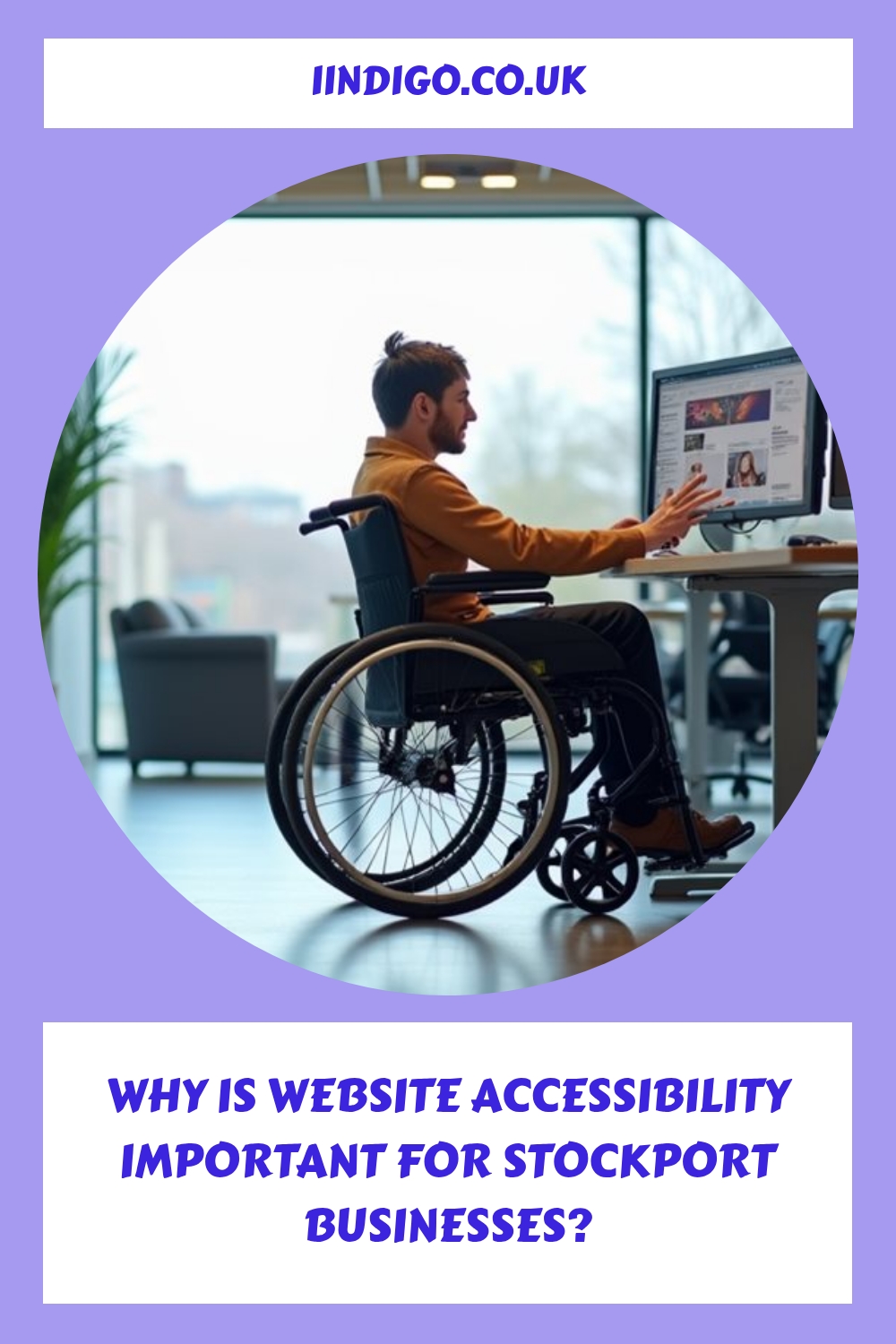
Website accessibility isn’t just about legal compliance under the Equality Act 2010—it’s a strategic business decision that expands your customer base, boosts search engine rankings, and increases revenue opportunities. When you make your Stockport business website accessible, you’re tapping into a market segment with considerable spending power while avoiding costly discrimination claims. Accessible websites typically see 20% higher engagement rates and attract diverse demographics across all age groups. Understanding these benefits reveals why accessibility should be your top digital priority.
Legal Compliance Requirements Under the Equality Act 2010

While many businesses focus primarily on aesthetic design and functionality, they often overlook a critical legal obligation that affects millions of potential customers.
The Equality Act 2010 requires your business to make reasonable adjustments for disabled users, and your website falls squarely under this legislation. You’re legally obligated to guarantee your digital presence doesn’t discriminate against people with disabilities.
Understanding these legal standards isn’t optional—it’s crucial for protecting your business from potential lawsuits and discrimination claims.
Effective compliance strategies include conducting regular accessibility audits, implementing proper alt text for images, making certain keyboard navigation works seamlessly, and maintaining adequate color contrast ratios.
Failing to meet these requirements could result in legal action, financial penalties, and notable reputational damage that affects your bottom line.
Expanding Your Customer Base in Stockport’s Diverse Market
Beyond the legal imperatives of accessibility compliance, you’re missing out on considerable revenue opportunities if your website isn’t designed for Stockport’s remarkably diverse population.
Inaccessible websites are literally turning away customers and their money in Stockport’s thriving, diverse marketplace.
When you implement proper accessibility features, you’re not merely accommodating disabilities—you’re tapping into a customer segment that controls substantial spending power and demonstrates fierce brand loyalty.
Stockport’s diverse demographics present unique opportunities for targeted marketing strategies. Accessible websites naturally perform better across different age groups, language preferences, and technological capabilities.
You’ll discover that features like clear navigation, readable fonts, and intuitive design appeal to elderly customers, busy parents, and tech-savvy millennials alike.
Consider this: accessible websites typically see 20% higher engagement rates.
Improving Search Engine Rankings and Online Visibility

When you optimize your website for accessibility, you’re simultaneously elevating your search engine rankings through factors that Google’s algorithms actively reward.
Search engines favor sites with clear navigation, proper heading structures, and descriptive alt text—all fundamental accessibility features. These SEO techniques naturally improve your site’s crawlability and user experience metrics.
Website optimization for accessibility creates semantic HTML that search engines can easily interpret.
When you implement proper heading hierarchies, meaningful link text, and structured data, you’re speaking Google’s language directly. Your site’s loading speed improves when you optimize images with alt attributes, while keyboard navigation boosts overall usability scores.
These improvements translate into higher search rankings, increased organic traffic, and better online visibility for your Stockport business, creating a competitive advantage in local search results.
Enhancing User Experience for All Website Visitors
Accessible design fundamentally transforms how every visitor interacts with your website, creating an inclusive digital environment that serves users regardless of their abilities or circumstances.
When you prioritize accessibility, you’re streamlining the user experience for everyone, not solely those with disabilities. Clear navigation, readable fonts, and intuitive layouts benefit all visitors, whether they’re using screen readers, mobile devices, or browsing in challenging conditions.
You’ll notice improved engagement metrics when accessibility features reduce friction throughout the browsing experience. Alt text for images helps visually impaired users while also supporting those with slow internet connections.
Keyboard navigation assists users with motor impairments and power users who prefer shortcuts. By collecting user feedback specifically about accessibility features, you can continuously refine your site’s usability, guaranteeing every visitor enjoys a seamless, efficient experience that encourages return visits.
Increasing Conversion Rates and Revenue Opportunities

When you make your website accessible, you’re not merely doing the right thing—you’re opening doors to considerable revenue growth that many businesses overlook.
By expanding your reach to include users with disabilities, you’re tapping into a market of over one billion people worldwide who represent trillions in annual disposable income.
The improved user experience that comes with accessibility improvements doesn’t merely benefit users with disabilities; it creates a more seamless, more intuitive experience for all visitors, directly translating to higher conversion rates and increased sales.
Broader Market Reach
The digital marketplace rewards businesses that cast the widest possible net, and accessibility improvements directly translate to expanded customer bases and increased revenue streams.
When you prioritize website accessibility, you’re not merely helping users with disabilities—you’re opening doors to a broader audience that includes aging populations, people with temporary impairments, and users traversing challenging environments.
This strategic approach to market expansion means capturing customers your competitors might overlook.
Consider users with visual impairments who rely on screen readers, individuals with motor difficulties who need keyboard navigation, or people with cognitive differences who benefit from clear, simple layouts.
Each accessibility improvement you implement removes barriers that prevent potential customers from engaging with your business, creating meaningful opportunities for sustainable growth.
Enhanced User Experience
Revenue growth often stems from seemingly small advancements that compound over time, and accessibility upgrades create precisely this type of multiplicative effect on your bottom line.
When you implement accessible design features, you’re not merely helping users with disabilities—you’re creating a more seamless experience for everyone. Clear navigation, readable fonts, and intuitive layouts reduce friction points that typically cause visitors to abandon their purchasing experience.
Accessible websites generate more positive user feedback because they eliminate common frustrations like confusing menus or hard-to-read text.
This improved experience translates directly into higher user engagement rates, keeping potential customers on your site longer. The longer they stay, the more likely they’ll convert into paying customers, creating a direct path from accessibility improvements to increased revenue.
Building Brand Reputation as an Inclusive Business
As digital environments evolve rapidly, businesses that prioritize website accessibility don’t just comply with regulations—they actively cultivate a reputation as forward-thinking, inclusive organizations.
When you demonstrate genuine commitment to accessibility, you’re signaling that your business values every customer, regardless of their abilities. This approach builds notable brand loyalty among disabled users and their networks, who often become your most vocal advocates.
Your accessibility efforts also showcase social responsibility, positioning your company as one that genuinely cares about community inclusion.
Modern consumers increasingly support businesses that align with their values, and accessibility represents a clear stance on equality. You’ll find that inclusive practices attract positive media attention, improve your company’s image, and differentiate you from competitors who haven’t prioritized accessibility.
Reducing Risk of Discrimination Claims and Legal Action

While brand reputation matters considerably, protecting your business from legal vulnerabilities carries equally important weight in today’s regulatory environment.
You’re operating in an era where discrimination awareness has reached unprecedented levels, and courts increasingly recognize digital accessibility as a fundamental right. When your website excludes users with disabilities, you’re potentially violating equality legislation that could result in costly lawsuits.
The legal implications extend far beyond simple compliance checkboxes.
Discrimination claims can drain your resources through lengthy court proceedings, substantial financial penalties, and mandatory accessibility audits. You’ll face not just immediate costs but also ongoing legal oversight that restricts your operational flexibility.
Future-Proofing Your Digital Presence for Changing Demographics
Your digital presence needs to anticipate tomorrow’s users, not merely today’s requirements.
As the population ages and technology standards evolve, you’ll find that accessibility features become crucial for reaching broader markets rather than optional add-ons.
The growing demand for inclusive design isn’t merely a trend—it’s a fundamental shift that’ll determine whether your business stays relevant in an increasingly diverse digital environment.
Aging Population Digital Needs
Demographics don’t lie—by 2030, one in six people globally will be 60 or older, and this rapidly expanding population brings unique digital needs that can’t be ignored.
Your website must accommodate users with varying levels of digital literacy, guaranteeing navigation remains intuitive even for those less comfortable with technology. Clear, simple interfaces become crucial when targeting this demographic.
Older users often rely on assistive technology like screen readers, magnifiers, or voice recognition software. If your site isn’t compatible with these tools, you’re excluding a notable customer base.
Consider larger fonts, high contrast colors, and simplified layouts that reduce cognitive load.
This demographic shift represents considerable purchasing power. By addressing their accessibility needs now, you’re positioning your Stockport business to capture this growing market segment effectively.
Evolving Accessibility Technology Standards
As technology standards continue their relentless evolution, you can’t afford to build your website accessibility features on yesterday’s requirements.
Today’s accessibility innovations are rapidly transforming how users interact with digital content, making traditional approaches obsolete within months rather than years.
WCAG guidelines regularly update to reflect new technology advancements, and what meets current compliance standards might fall short tomorrow.
Voice navigation, AI-powered screen readers, and advanced assistive technologies are reshaping accessibility expectations. Your Stockport business needs a forward-thinking approach that anticipates these changes.
Instead of merely meeting minimum requirements, invest in flexible accessibility frameworks that adapt to emerging standards.
This proactive strategy protects your investment while guaranteeing your website remains inclusive as technology evolves, keeping you ahead of competitors still relying on outdated accessibility practices.
Inclusive Design Market Growth
While the global population ages and disability awareness increases, the inclusive design market is experiencing unprecedented growth that’ll reshape how businesses approach digital accessibility.
You’re witnessing a fundamental shift where accessibility isn’t just compliance—it’s competitive advantage. Market growth projections show the assistive technology sector expanding rapidly, with consumers increasingly choosing brands that prioritize inclusion.
Your Stockport business can capitalize on this trend by implementing inclusive design principles now. Companies embracing accessibility early often capture larger market shares and build stronger customer loyalty.
The demographic changes aren’t slowing down; they’re accelerating. By investing in accessible design today, you’re positioning your business to serve an expanding customer base while competitors scramble to catch up tomorrow.
Frequently Asked Questions
How Much Does It Cost to Make a Stockport Business Website Accessible?
You’ll find accessibility costs vary widely based on your site’s complexity. Budget considerations include $3,000-$15,000 for professional audits and remediation. You can reduce expenses by implementing accessible design from the start rather than retrofitting existing websites.
What Specific Accessibility Tools Should I Implement on My Website First?
You should start with color contrast adjustments and keyboard navigation features. These two accessibility tools provide the biggest impact for users with visual impairments and mobility limitations, making your website immediately more inclusive and usable.
How Long Does It Typically Take to Audit and Fix Accessibility Issues?
You’ll need 2-4 weeks for a thorough accessibility audit, depending on your site’s complexity. Fixing timelines vary considerably – minor issues take days, while major structural changes require 1-3 months for complete implementation.
Do Small Stockport Businesses Really Need to Worry About Website Accessibility Compliance?
Yes, you absolutely need to worry about compliance. Your small business faces real legal obligations under accessibility laws, regardless of size. You’re not exempt from potential lawsuits or losing customers who can’t access your website.
Which Accessibility Standards Should My Business Website Follow in the UK?
You should follow WCAG Guidelines 2.1 AA standards for your website. These guarantee legal compliance with UK accessibility laws, protecting you from discrimination claims while making your site usable for everyone, including customers with disabilities.
Final Thoughts
You can’t afford to ignore website accessibility in today’s competitive Stockport market. It’s more than about legal compliance—it’s about smart business strategy. By making your site accessible, you’ll reach more customers, boost your SEO rankings, and protect your reputation. The investment pays dividends through increased conversions and reduced legal risks. Start implementing accessibility features now, and you’ll position your business for long-term success in our increasingly diverse digital environment.
- How to Plan a Content Calendar That Works - 29/10/2025
- SEO Content vs. Social Media Content: What’s the Difference? - 23/10/2025
- The Best Types of Content for Service Businesses - 16/10/2025




